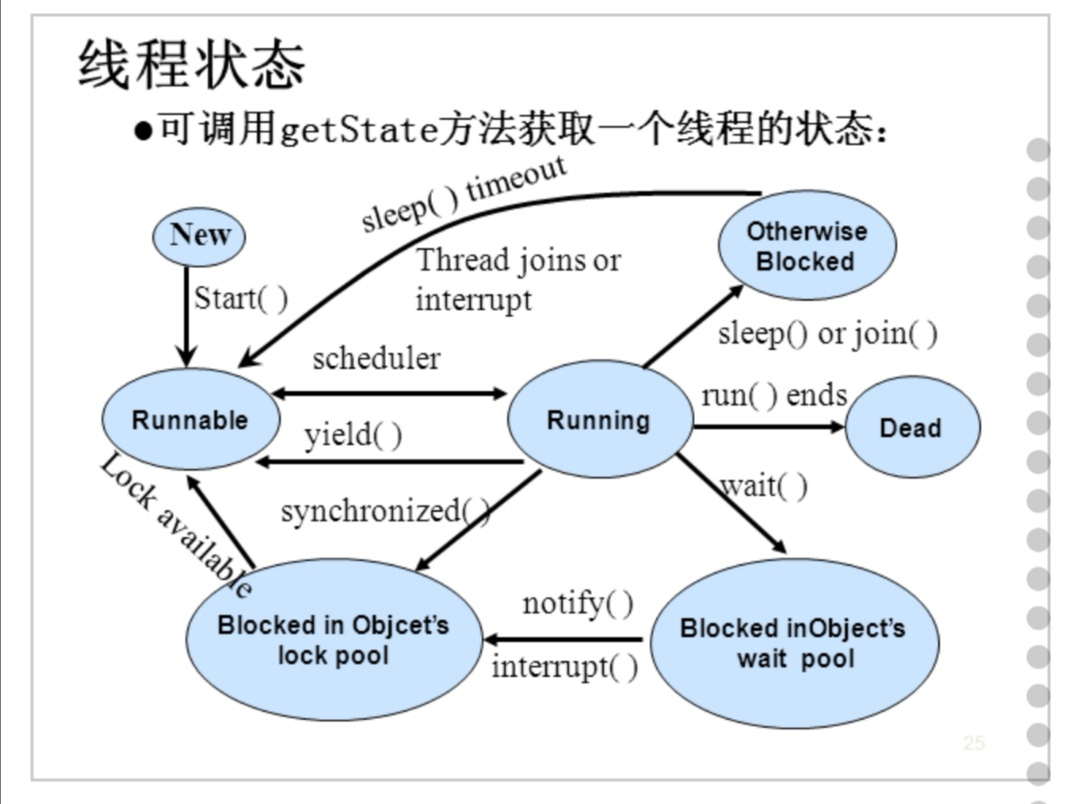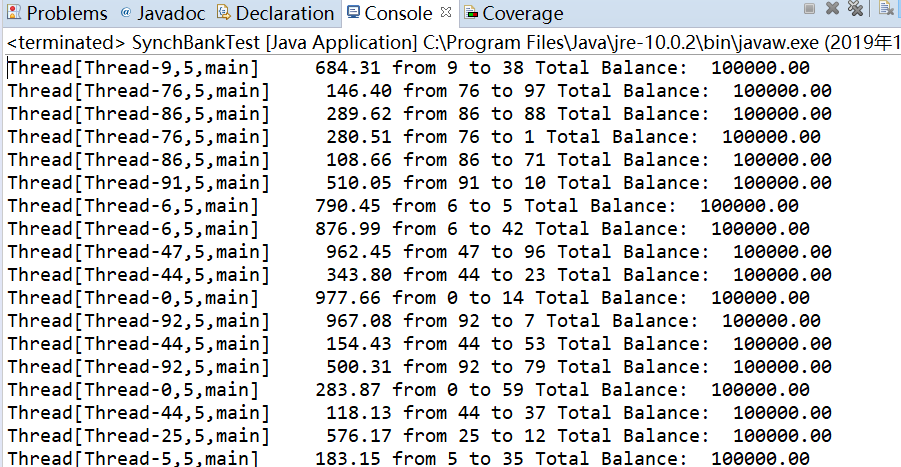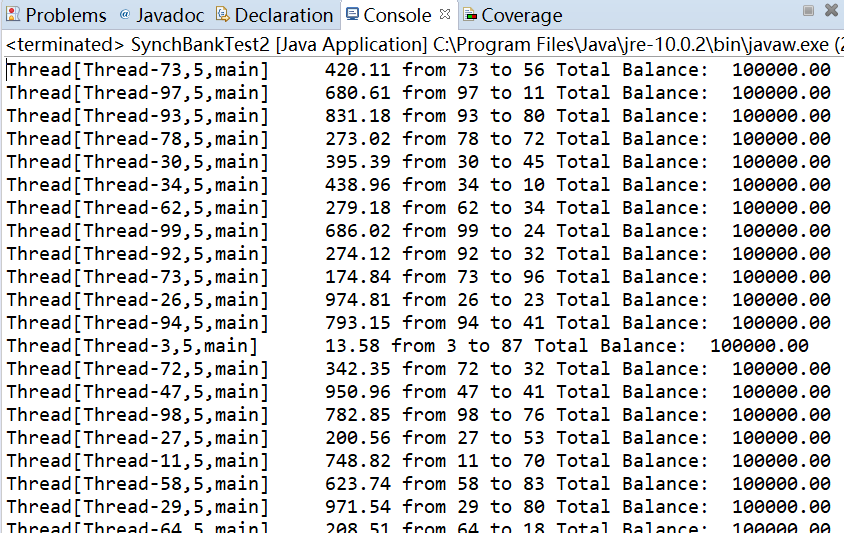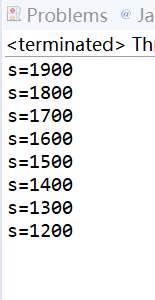201871010106-丁宣元 《面向对象程序设计(java)》第十七周学习总结
正文开头:
|
项目 |
内容 |
|
这个作业属于哪个课程 |
https://home.cnblogs.com/u/nwnu-daizh/ |
|
这个作业的要求在哪里 |
https://www.cnblogs.com/nwnu-daizh/p/12073034.html |
|
作业学习目标 |
(1) 掌握线程同步的概念及实现技术; (2) 线程综合编程练习 |
正文内容:
第一部分:总结线程同步技术
14-3线程的状态
1.七种: new新创建,
Runnable可运行,
Running运行
Blocked被阻塞,
Waiting等待,
Timed waiting计时等待,
Terminated被终止

14-4
1.多线程调度
采用优先级策略:优先级高的先执行,低的后执行。任务急得线程,优先级较高。同优先级的线程按“先进先出”的队列原则。
2.Thread类有三个与线程有关的静态量:
MAX_PRIORITY:最大优先级,值为10;
MIN_PRIORITY:最小优先级,值为1:
NORM_PRIORITY:默认优先级,值为5.
调用setPriority(int a)重置当前线程的优先级,a取值可以是前述的三个静态量;
调用getPriority()获取当前的线程优先级。
3.多线程并发存在问题:
Java通过多线程的并发运行提高系统资源利用率,改善系统性能。
存在问题:
多个线程的相对执行顺序不确定;
线程执行顺序不确定性会产生执行结果的不确定性;
在多线程对共享数据操作时常常会产生不确定性。
4.线程的同步
多线程并发运行不确定性问题解决方案:引入线程同步机制;
在Java中线程同步方法有两种:
(1)ReentrantLock类
锁对象与条件对象
myLock.lock();
try { critical section }
finally{
myLock.unlock();}
要点:
锁用来保护代码片段,保证任何时刻只能有一个线程被保护执行的代码
锁管理试图进入被保护的代码段的线程
锁可拥有一个或多个相关的条件对象
每个条件对象管理那些已经进入被保护得到代码段但还不能运行的线程
(2)synchronized关键字
某个类内方法用synchronized修饰符后,该方法被称为同步线程
只要某个线程正在访问同步方法,其他线程欲要访问同步方法就会被阻塞,直至线程从同步方法返回前唤醒被阻塞线程,其他线程方法可能进入同步方法
使用wait(),notify,notifyAll()
第二部分:实验部分
实验1:测试程序并进行代码注释。
测试程序1:
在Elipse环境下调试教材651页程序14-7,结合程序运行结果理解程序;
掌握利用锁对象和条件对象实现的多线程同步技术。
代码:
package synch; /** * This program shows how multiple threads can safely access a data structure. * @version 1.31 2015-06-21 * @author Cay Horstmann */ public class SynchBankTest { public static final int NACCOUNTS = 100; public static final double INITIAL_BALANCE = 1000; public static final double MAX_AMOUNT = 1000; public static final int DELAY = 10; public static void main(String[] args) { Bank bank = new Bank(NACCOUNTS, INITIAL_BALANCE); for (int i = 0; i < NACCOUNTS; i++) { int fromAccount = i; Runnable r = () -> { try { while (true) { int toAccount = (int) (bank.size() * Math.random()); double amount = MAX_AMOUNT * Math.random(); bank.transfer(fromAccount, toAccount, amount); Thread.sleep((int) (DELAY * Math.random())); } } catch (InterruptedException e) { } }; Thread t = new Thread(r); t.start();//启动线程 } } }
package synch; import java.util.*; import java.util.concurrent.locks.*; /** * A bank with a number of bank accounts that uses locks for serializing access. * @version 1.30 2004-08-01 * @author Cay Horstmann */ public class Bank//银行取款操作 { private final double[] accounts;//数组,存储账户 private Lock bankLock; private Condition sufficientFunds; /** * Constructs the bank. * @param n the number of accounts * @param initialBalance the initial balance for each account */ public Bank(int n, double initialBalance) { accounts = new double[n]; Arrays.fill(accounts, initialBalance); bankLock = new ReentrantLock(); sufficientFunds = bankLock.newC ondition(); } /** * Transfers money from one account to another. * @param from the account to transfer from * @param to the account to transfer to * @param amount the amount to transfer */ public void transfer(int from, int to, double amount) throws InterruptedException//保护锁来保护检查与转账动作 { bankLock.lock(); try { while (accounts[from] < amount)//钱不够 sufficientFunds.await(); //进入阻塞队列 System.out.print(Thread.currentThread()); accounts[from] -= amount; //模拟转账 System.out.printf(" %10.2f from %d to %d", amount, from, to); accounts[to] += amount; System.out.printf(" Total Balance: %10.2f%n", getTotalBalance()); sufficientFunds.signalAll();//另一个线程转账 } finally { bankLock.unlock();//释放这个锁 } } /** * Gets the sum of all account balances. * @return the total balance */ public double getTotalBalance() { bankLock.lock();//获得锁 try { double sum = 0; for (double a : accounts) sum += a; return sum; } finally { bankLock.unlock();//释放这个锁 } } /** * Gets the number of accounts in the bank. * @return the number of accounts */ public int size() { return accounts.length; } }
结果:

测试程序2:
在Elipse环境下调试教材655页程序14-8,结合程序运行结果理解程序;
掌握synchronized在多线程同步中的应用。
代码:
package synch2; /** * This program shows how multiple threads can safely access a data structure, * using synchronized methods. * @version 1.31 2015-06-21 * @author Cay Horstmann */ public class SynchBankTest2 { public static final int NACCOUNTS = 100; public static final double INITIAL_BALANCE = 1000; public static final double MAX_AMOUNT = 1000; public static final int DELAY = 10; public static void main(String[] args) { Bank bank = new Bank(NACCOUNTS, INITIAL_BALANCE); for (int i = 0; i < NACCOUNTS; i++) { int fromAccount = i; Runnable r = () -> {//Runnable接口创建线程try { while (true) { int toAccount = (int) (bank.size() * Math.random()); double amount = MAX_AMOUNT * Math.random(); //产生随机数 bank.transfer(fromAccount, toAccount, amount);//同行之间进行转账Thread.sleep((int) (DELAY * Math.random()));//} } catch (InterruptedException e) { } }; Thread t = new Thread(r); t.start();//启动线程 } } }调用sleep方法
package synch2; import java.util.*; /** * A bank with a number of bank accounts that uses synchronization primitives. * @version 1.30 2004-08-01 * @author Cay Horstmann */ public class Bank { private final double[] accounts; //accounts数组,双精度 /** * Constructs the bank. * @param n the number of accounts * @param initialBalance the initial balance for each account */ public Bank(int n, double initialBalance) { accounts = new double[n]; Arrays.fill(accounts, initialBalance); } /** * Transfers money from one account to another. * @param from the account to transfer from * @param to the account to transfer to * @param amount the amount to transfer */ public synchronized void transfer(int from, int to, double amount) throws InterruptedException { while (accounts[from] < amount) wait();//调用wait()方法处于等待状态System.out.print(Thread.currentThread()); accounts[from] -= amount; System.out.printf(" %10.2f from %d to %d", amount, from, to); accounts[to] += amount; System.out.printf(" Total Balance: %10.2f%n", getTotalBalance()); notifyAll();//唤醒等待的线程} /** * Gets the sum of all account balances. * @return the total balance */ public synchronized double getTotalBalance()//synchronized { double sum = 0; for (double a : accounts) sum += a; return sum; } /** * Gets the number of accounts in the bank. * @return the number of accounts */ public int size() { return accounts.length; } }
结果:
测试程序3:
在Elipse环境下运行以下程序,结合程序运行结果分析程序存在问题;
尝试解决程序中存在问题。
|
class Cbank { private static int s=2000; public static void sub(int m) { int temp=s; temp=temp-m; try { Thread.sleep((int)(1000*Math.random())); } catch (InterruptedException e) { } s=temp; System.out.println("s="+s); } }
class Customer extends Thread { public void run() { for( int i=1; i<=4; i++) Cbank.sub(100); } } public class Thread3 { public static void main(String args[]) { Customer customer1 = new Customer(); Customer customer2 = new Customer(); customer1.start(); customer2.start(); } } |
代码:
class Cbank { private static int s=2000; public static void sub(int m) { int temp=s; temp=temp-m; try { Thread.sleep((int)(1000*Math.random())); } catch (InterruptedException e) { } s=temp; System.out.println("s="+s); } } class Customer extends Thread { public void run() { for( int i=1; i<=4; i++) Cbank.sub(100); } } public class Thread3 { public static void main(String args[]) { Customer customer1 = new Customer(); Customer customer2 = new Customer(); customer1.start(); customer2.start(); } }
结果:

问题:输出结果应为1900—1200,控制台上显示结果不对,要利用锁。
package synch; class Cbank { private static int s=2000; public synchronized static void sub(int m) { int temp=s; temp=temp-m; try { Thread.sleep((int)(1000*Math.random())); } catch (InterruptedException e) { } s=temp; System.out.println("s="+s); } } class Customer extends Thread { public void run() { for( int i=1; i<=4; i++){ Cbank.sub(100); } } public class Thread31 { public static void main(String args[]) { Customer customer1 = new Customer(); Customer customer2 = new Customer(); customer1.start(); customer2.start(); } }
结果:

实验2 编程练习
利用多线程及同步方法,编写一个程序模拟火车票售票系统,共3个窗口,卖10张票,程序输出结果类似(程序输出不唯一,可以是其他类似结果)。
Thread-0窗口售:第1张票
Thread-0窗口售:第2张票
Thread-1窗口售:第3张票
Thread-2窗口售:第4张票
Thread-2窗口售:第5张票
Thread-1窗口售:第6张票
Thread-0窗口售:第7张票
Thread-2窗口售:第8张票
Thread-1窗口售:第9张票
Thread-0窗口售:第10张票
代码:
public class shoupiao { public static void main(String[] args) { thread1 mythread = new thread1(); Thread ticket1 = new Thread(mythread); ticket1.start(); Thread ticket2 = new Thread(mythread); ticket2.start(); Thread ticket3 = new Thread(mythread); ticket3.start(); } } class thread1 implements Runnable { int ticket = 1; boolean flag = true; @Override public void run() { while (flag) { try { Thread.sleep(500); } catch (InterruptedException e) { // TODO Auto-generated catch block e.printStackTrace(); } synchronized (this) { if (ticket <= 10) { System.out.println(Thread.currentThread().getName() + "窗口售:第" + ticket + "张票"); ticket++; } if (ticket > 10) { flag = false; } } } } }
结果:


实验总结:
通过本次实验,我学到了:1.线程同步的概念及实现技术 2.对线程有更进一步的理解
通过本次实验,我进一步了解了线程,虽然在理解上还存在一些不足,但对线程有了稍清楚的了解。在java上要多下一些功夫,把以前的缺失的知识弥补回来。